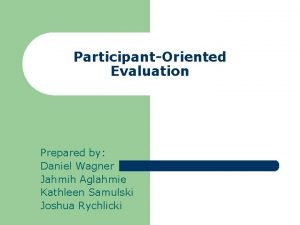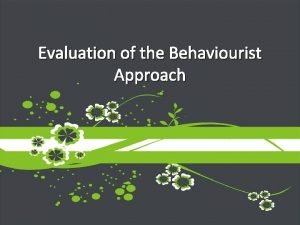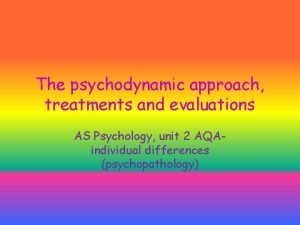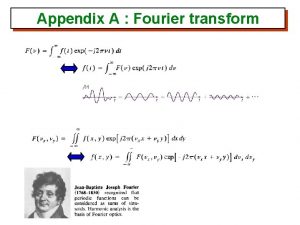Overview of assessment approach Appendix 2 Evaluation of



- Slides: 3

Overview of assessment approach Appendix 2 – Evaluation of Frailty Programme Interviews One-to-one interviews with 15 key stakeholders from the main organisations involved Survey Multiple choice survey (n=24 respondents) covering key elements of ALP frailty programme evaluation PLG meeting Discussion with key system stakeholders at first Professional Leaders Group meeting SLG-24 Apr 15 vf. pptx Data analysis Review of key data & documents relating to ALP frailty programme Note: PAH inpatient data from May 2014 is unreliable. This has limited the both the ALP frailty programme team, and this review to assess the impact on non-elective admissions 0

Executive Summary Supporting material Assessment of ALP frailty programme highlighted a number of positive elements • Agreement between the CCG and providers on the problem to solve, broad approach and the high level targets • Anecdotal evidence of examples of more integrated working between frontline staff (e. g. in CARS teams) • Care home admissions reduced by 14% from the 12 care homes targeted I However, programme impact slower than originally hoped. Three main reasons: 1 Lack of alignment between CCG and SEPT on how to deliver the targets • Unresolved trade-off between desire for transformational pathway redesign, with greater focus on prevention, vs. a more immediate focus on using the money to "plug gaps" and "get things done" II 2 The programme lacked the practical process / governance mechanisms needed to move at pace • Provider sign off was slow, partly due to low meeting attendance (~30% absence) • CCG approval was required for all plans, resulting in further delays III 3 Creating and sustaining a high level of engagement was a challenge • Frontline staff were unclear about the programme's aims, and their role within it • Many managers saw the programme as another add-on • Many GPs found it difficult to engage: perceive a lot of extra paperwork with limited influence on care IV Consequently, the programme has lost momentum, is perceived as having delivered only incremental change – though some also argue that it is too early to assess the impact V SLG-24 Apr 15 vf. pptx 1

Frailty survey responses – summary There was clear agreement on the problem the programme was trying to solve (i. e. high and increasing spend on frail patients) Goals Generally positive about the goals The programme had a clear target (i. e. to reduce non-elective admissions) There was clear alignment among system leaders on what the programme needed to deliver (e. g. fundamental pathway redesign) Governance Project governance allowed quick decision making and fast implementation of plans Incentives were sufficiently aligned to ensure all organisations shared the same priorities and goals Less positive about the level of alignment & engagement Initiatives were clearly communicated across all levels of relevant organisations Managers were clear about the purpose of the programme, and the benefits it would deliver Engagement Managers understood what they needed to do differently in their day-to-day job Frontline staff were clear about the purpose of the programme, and the benefits it would deliver 0 Frontline staff understood what they needed to do differently in their day-to-day job 0 The programme has resulted in a tangible change in the way we deliver care to the frail elderly People see positive impact, but with potential to go further The programme has resulted in teams working together in a better way Impact Specific initiatives have delivered tangible benefits to the frail elderly The programme as a whole has helped to reduce hospital admissions among the frail elderly Strongly disagree Disagree Neutral Agree Strongly agree # Number of responses Note: respondents also given opportunity to additional information for each section, and were asked to identify 3 successes and 3 challenges the frailty programme faced Source: Frailty e-survey, March 2015; 24 respondents; BCG analysis SLG-24 Apr 15 vf. pptx 2





